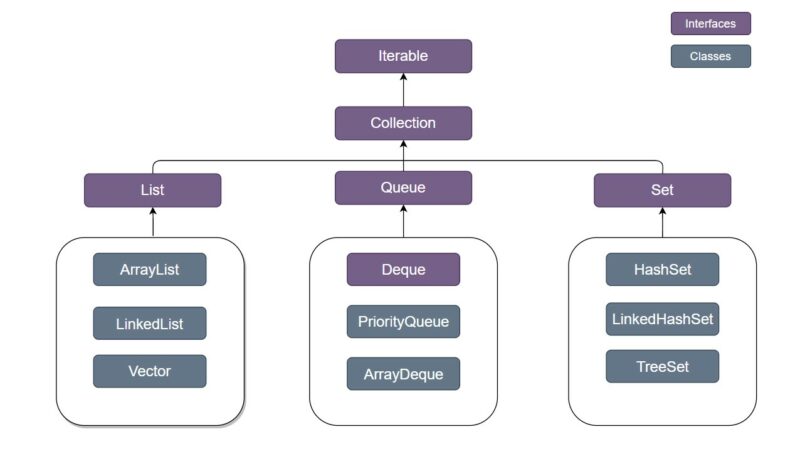Collection in Java represents a group of objects. It is simply an object that contains other objects.
Collections in Java – Collection Framework
The Collection framework in Java provides efficient implementations of essential data structures. It provides an architecture to store and manipulate objects inside the collection/group.
The Collection framework contains interfaces and classes that we can use to write programs for manipulating objects within a group.
Most used Collection interfaces:
- Collection
- List
- Set
- Map
- Queue
- Deque
Most used Collection classes are implementations of List, Set, and Map interfaces:
- ArrayList, LinkedList
- HashSet, LinkedHashSet, TreeSet
- HashMap, LinkedHashMap, TreeMap
Hierarchy of Collection Framework
Note: Map is not included since Map does not extend the Collection interface.

Iterable Interface
The Iterable interface gives us the ability to iterate through the elements of a collection. This means a class that implements the Java Iterable interface can have its elements iterated. It contains only one abstract method.
Iterator<T> iterator()
The iterator() method returns the Iterator of type T.
Iterator Interface
An Iterator is an object that can be used to loop through collections.
The Iterator Interface has three methods:
| Method | Description | |
|---|---|---|
| 1 | public boolean hasNext() | It returns true if the iterator has more elements otherwise it returns false. |
| 2 | public Object next() | It returns the element and moves the cursor pointer to the next element. |
| 3 | public void remove() | It removes the last elements returned by the iterator. It is less used. |
Collection Interface
All collections except Maps inherit the Collection interface. The Collection interface provides many useful methods for working with collections in Java.
Methods of the Collection Interface
| Method | Description | |
|---|---|---|
| public boolean add(E e) | It is used to insert an element in this collection. | |
| public boolean addAll(Collection<? extends E> c) | It is used to insert the specified collection elements in the invoking collection. | |
| public boolean remove(Object element) | It is used to delete an element from the collection. | |
| public boolean removeAll(Collection<?> c) | It is used to delete all the elements of the specified collection from the invoking collection. | |
| default boolean removeIf(Predicate<? super E> filter) | It is used to delete all the elements of the collection that satisfy the specified predicate. | |
| public boolean retainAll(Collection<?> c) | It is used to delete all the elements of invoking collection except the specified collection. | |
| public int size() | It returns the total number of elements in the collection. | |
| public void clear() | It removes the total number of elements from the collection. | |
| public boolean contains(Object element) | It is used to search an element. | |
| public boolean containsAll(Collection<?> c) | It is used to search the specified collection in the collection. | |
| public Iterator iterator() | It returns an iterator. | |
| public Object[] toArray() | It converts collection into array. | |
| public <T> T[] toArray(T[] a) | It converts collection into array. Here, the runtime type of the returned array is that of the specified array. | |
| public boolean isEmpty() | It checks if collection is empty. | |
| default Stream<E> parallelStream() | It returns a possibly parallel Stream with the collection as its source. | |
| default Stream<E> stream() | It returns a sequential Stream with the collection as its source. | |
| default Spliterator<E> spliterator() | It generates a Spliterator over the specified elements in the collection. | |
| public boolean equals(Object element) | It matches two collections. | |
| public int hashCode() | It returns the hash code number of the collection. |
This was an introduction to Collections in Java. Proceed to the next lesson to learn more about the Java ArrayList class.
Happy Learning!